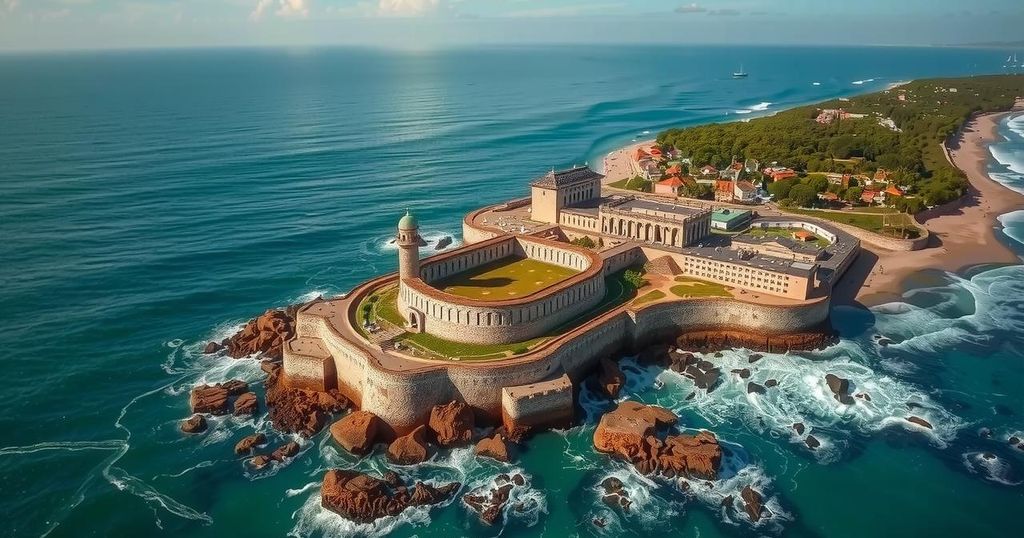Ghana’s Historic Coastal Forts at Risk Due to Climate Change

Ghana is losing historic coastal forts due to climate change, with severe tidal waves causing significant coastline erosion. It faces an annual loss of approximately two meters, putting communities and heritage sites at risk. Notable forts, including Fort Prinzenstein and Fort Kongenstein, have already been severely damaged or lost entirely. Efforts like the Keta Sea Defence Wall and resilience projects funded by international bodies aim to protect these sites and local communities.
Ghana is experiencing significant loss of its historic coastal forts due to climate change, particularly from severe tidal waves originating from the Atlantic Ocean. The nation’s coastline, which stretches over 550 kilometers, is receding at an alarming rate, with an average annual erosion rate of two meters as identified by a recent study from the Institute for Environment and Sanitation Studies. Moreover, certain coastal areas have even lost up to 17 meters of land in total. The rise in sea levels poses a dual threat: it endangers the livelihoods of vulnerable coastal communities and jeopardizes the preservation of Ghana’s essential historic structures, including its forts and castles built during the trans-Atlantic slave trade era. Among the affected sites is Fort Prinzenstein in Keta, a 240-year-old establishment that has suffered extensive damage over the last decade, with its caretaker, James Ocloo Akorli, noting that two-thirds of it is submerged. “Eight of its ten dungeons, originally built to hold enslaved Africans during the trans-Atlantic slave trade, were completely submerged before a sea defense wall was erected to protect what remains of the monument,” he stated. Similarly, Fort Kongenstein in the Greater Accra Region has succumbed to the relentless tidal waves, leaving no trace of its existence. Fort Fredensborg is also reduced to a shadow of its former self, while the coastal community of Dzakplagbe, relocated from Fuveme due to erosion, now sits precariously as the sea threatens it as well. The Western Region’s Anlo village is caught between rising tides and a swelling lagoon, shrinking to as little as 60 to 100 meters wide. Such conditions have led to increased desertion of homes, particularly in suburbs of Accra like Glefe, where tidal destruction has displaced many residents. To address these challenges, initiatives such as the 8.3-kilometer Keta Sea Defence Wall have been constructed with significant investment. Furthermore, projects like the World Bank-funded $155 million initiative aim to enhance coastal resilience and restore critical ecosystems along the coastline.
The historical forts along Ghana’s coastline represent critical elements of the nation’s cultural heritage, primarily serving as monuments to the trans-Atlantic slave trade. However, climate change is posing increasingly dire threats to these structures and the surrounding coastal communities, jeopardizing both historical preservation and the livelihoods of residents. With rising sea levels and powerful tidal waves contributing to rampant coastal erosion, Ghana is at a critical juncture that necessitates urgent intervention. Various projects funded by international entities aim to reinforce and preserve these historic sites while helping local populations adapt to the changing environmental conditions.
In summary, Ghana’s coastal heritage is increasingly under threat from climate change, primarily through severe erosion and rising sea levels. Historic forts, such as Fort Prinzenstein and Fort Kongenstein, have suffered devastating losses, highlighting the urgent need for proactive measures to combat coastal erosion. Initiatives like the Keta Sea Defence Wall and other resilience projects demonstrate a commitment to safeguarding both the land and the historic monuments that define Ghana’s rich cultural landscape.
Original Source: www.rfi.fr








